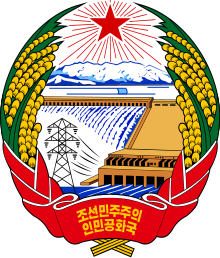Coat of Arms of North Korea
| National Emblem of the Democratic People's Republic of Korea 조선민주주의인민공화국의 국장 |
|
|---|---|
 |
|
| Details | |
| Armiger | Democratic People's Republic of Korea |
| Adopted | 1993 |
| Crest | Radiant red star |
| Escutcheon | Hydroelectric power plant(Sup'ung Dam); power line; Paektu Mountain |
| Supporters | Ears of rice |
| Motto | Democratic People's Republic of Korea |
| Other elements | Red ribbon |
| Earlier versions | (1946), July 1948, September 1948 |
The National Emblem of the Democratic People's Republic of Korea is the coat of arms of North Korea, officially known as the Democratic People's Republic of Korea. The current version adopted in 1993 is based on a design that was used since the foundation of the republic in 1948. Two previous versions were briefly in use in the late 1940s. Prominent features on the emblem are a red star, a hydroelectric plant (the Sup'ung dam) and Mount Paektu. The design bears similarities to the emblem of the Soviet Union and other emblems of the socialist heraldic style.
During the Liberation of Korea in 1945 by the Allies, Northern Korea had no emblem. The first equivalent of an emblem appeared on January 1, 1946, printed below a speech of Kim Il-sung in the newspaper Chǒngro. It features the Korean Peninsula surrounded by ribbons. This was the only time it was ever used, and between 1946 and 1948 a simple outline of the peninsula was displayed in its place. This was intended to signal that the North and the South are one country.
However, in July 1948 as the division of Korea loomed, North Korea adopted its first constitution. This constitution defined the North Korean emblem, but the emblem was in use for only two months. It features a furnace, as opposed to a hydroelectric plant on later designs.
On September 9, 1948, the Democratic People's Republic of Korea was declared and a new emblem adopted. This is evident in the chosen motif: the Sup'ung hydroelectric plant was built by the Imperial Japanese during their occupation of the Korean Peninsula, and as such was not comfortable as symbol of national pride for nationalistic Koreans. However, North Korean sources claim that Kim Il-sung was behind the design. In 1993, the emblem was further amended to feature Mount Paektu, which features as an important symbol of power and legitimacy for the Kim family dynasty in North Korean propaganda.
...
Wikipedia
